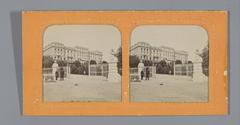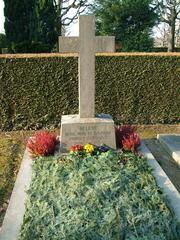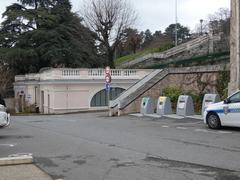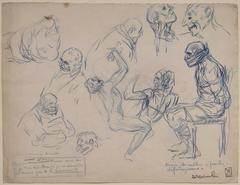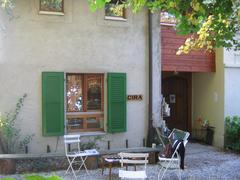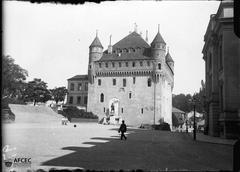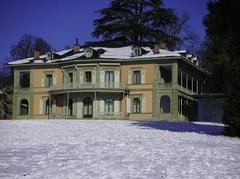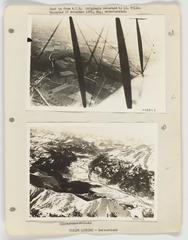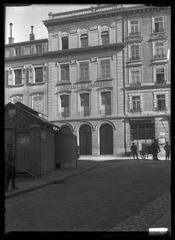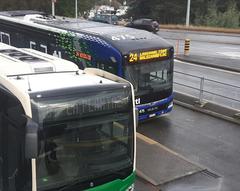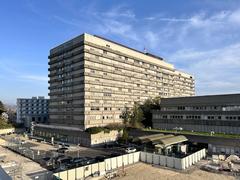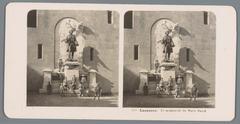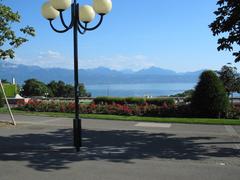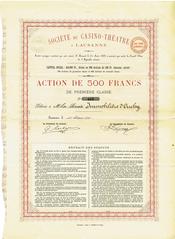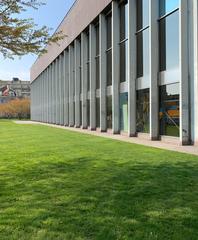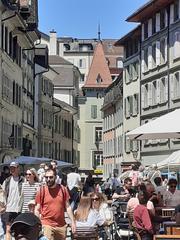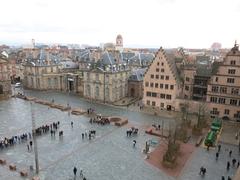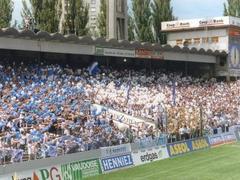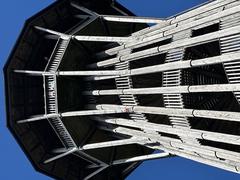Comprehensive Guide to Visiting Le Blaireau, Lausanne, Switzerland
Date: 24/07/2024
Introduction
Lausanne, a picturesque city nestled on the shores of Lake Geneva in Switzerland, is renowned for its rich historical tapestry and vibrant cultural scene. One of the city’s most cherished gems is Le Blaireau, a site that offers visitors an immersive experience into the region’s storied past and dynamic present. Lausanne’s origins trace back to the Roman era, when the military camp of Lousanna was established, evolving over centuries into a bustling medieval hub under the bishops of Lausanne (Wikipedia). Through periods of Bernese occupation and Napoleonic influence, Lausanne has continually reinvented itself, today standing as the capital of the Swiss canton of Vaud and an international cultural center (Britannica). Le Blaireau, with its charming architecture and historical significance, encapsulates this evolution, making it a must-visit for history enthusiasts and cultural aficionados alike. This guide provides a comprehensive overview of Le Blaireau, from its historical roots and cultural importance to practical visitor information and nearby attractions, ensuring a well-rounded and enriching experience for all who visit.
Table of Contents
- [Explore Le Blaireau - History, Visiting Hours, Tickets, and Key Attractions in Lausanne](#explore-le-blaireau---history-visiting-hours-tickets-and-key-attractions-in-lausanneexplore-le-blaireau---history-visiting-hours-tickets-and-key-attractions-in-lausanne)
- [Origins and Early History](#origins-and-early-historyorigins-and-early-history)
- [Medieval Development](#medieval-developmentmedieval-development)
- [The Bernese Occupation](#the-bernese-occupationthe-bernese-occupation)
- [The Napoleonic Era and Beyond](#the-napoleonic-era-and-beyondthe-napoleonic-era-and-beyond)
- [Modern Significance](#modern-significancemodern-significance)
- [Le Blaireau Today](#le-blaireau-todayle-blaireau-today)
- [Visitor Tips](#visitor-tipsvisitor-tips)
- [Key Attractions](#key-attractionskey-attractions)
- [Events and Festivals](#events-and-festivalsevents-and-festivals)
- [Practical Information](#practical-informationpractical-information)
- [FAQ Section](#faq-sectionfaq-section)
- [Call to Action](#call-to-actioncall-to-action)
- [Visiting Le Blaireau in Lausanne - History, Significance, Visitor Tips, and More](#visiting-le-blaireau-in-lausanne---history-significance-visitor-tips-and-morevisiting-le-blaireau-in-lausanne---history-significance-visitor-tips-and-more)
- [History of Le Blaireau](#history-of-le-blaireauhistory-of-le-blaireau)
- [Significance of Le Blaireau](#significance-of-le-blaireausignificance-of-le-blaireau)
- [Le Blaireau Visitor Tips](#le-blaireau-visitor-tipsle-blaireau-visitor-tips)
- [Dining Experience at Le Blaireau](#dining-experience-at-le-blaireaudining-experience-at-le-blaireau)
- [Cultural Events and Activities at Le Blaireau](#cultural-events-and-activities-at-le-blaireaucultural-events-and-activities-at-le-blaireau)
- [Practical Information about Le Blaireau](#practical-information-about-le-blaireaupractical-information-about-le-blaireau)
- [Le Blaireau Ticket Prices and Guided Tours](#le-blaireau-ticket-prices-and-guided-toursle-blaireau-ticket-prices-and-guided-tours)
- [FAQ about Le Blaireau](#faq-about-le-blaireaufaq-about-le-blaireau)
- [Nearby Attractions to Le Blaireau](#nearby-attractions-to-le-blaireaunearby-attractions-to-le-blaireau)
- [Conclusion](#conclusionconclusion)
- [Top Tips for Visiting Le Blaireau in Lausanne - Hours, Tickets, and More](#top-tips-for-visiting-le-blaireau-in-lausanne---hours-tickets-and-moretop-tips-for-visiting-le-blaireau-in-lausanne---hours-tickets-and-more)
- [Introduction](#introductionintroduction)
- [Getting There](#getting-theregetting-there)
- [Best Time to Visit](#best-time-to-visitbest-time-to-visit)
- [Visiting Hours and Tickets](#visiting-hours-and-ticketsvisiting-hours-and-tickets)
- [History and Cultural Significance](#history-and-cultural-significancehistory-and-cultural-significance)
- [Accommodation](#accommodationaccommodation)
- [Dining and Cuisine](#dining-and-cuisinedining-and-cuisine)
- [Attractions and Activities](#attractions-and-activitiesattractions-and-activities)
- [Safety Tips](#safety-tipssafety-tips)
- [Local Etiquette](#local-etiquettelocal-etiquette)
- [Shopping](#shoppingshopping)
- [Day Trips](#day-tripsday-trips)
- [Accessibility](#accessibilityaccessibility)
- [Budgeting](#budgetingbudgeting)
- [Useful Contacts](#useful-contactsuseful-contacts)
- [FAQ](#faqfaq)
- [Conclusion](#conclusionconclusion)
- [Visuals and Media](#visuals-and-mediavisuals-and-media)
- [Internal Links](#internal-linksinternal-links)
Explore Le Blaireau - History, Visiting Hours, Tickets, and Key Attractions in Lausanne
Origins and Early History
Le Blaireau, located in Lausanne, Switzerland, is steeped in rich history and cultural significance. The origins of Lausanne itself date back to the Roman era when a military camp named Lousanna was established near the lake, close to the present-day areas of Vidy and Ouchy (Wikipedia). This camp was built on the site of a Celtic settlement, and by the 2nd century AD, it was known as vikanor[um] Lousonnensium. The settlement moved to its current hilly location for defensive purposes after the fall of the Western Roman Empire.
Medieval Development
During the medieval period, Lausanne developed into a significant political, economic, and religious center. By the 11th century, it had become the center of secular rule under the bishops of Lausanne. The city flourished in the 12th and 13th centuries, culminating in the consecration of the Lausanne Cathedral in 1275 in the presence of Pope Gregory X and King Rudolf I of Germany (Britannica).
The Bernese Occupation
In 1536, Lausanne was invaded by forces from the canton of Bern, marking the beginning of a long period of Bernese domination that lasted until 1798. During this time, the Bernese introduced the Protestant Reformation, stripping the Lausanne Cathedral of its Roman Catholic trappings and removing many cultural treasures (Wikipedia).
The Napoleonic Era and Beyond
The status of Lausanne changed significantly during the Napoleonic Wars. In 1803, it became the capital of the newly formed Swiss canton of Vaud and joined the Swiss Federation (Britannica). This period marked the beginning of Lausanne’s modern history, characterized by its growing importance as a cultural and intellectual center.
Modern Significance
In the 20th century, Lausanne gained international recognition as a hub for sports and culture. The city became the headquarters of the International Olympic Committee in 1915, a status it owes to Pierre de Coubertin, the reviver of the Olympic Games (Olympics.com). Lausanne is also home to the Olympic Museum, which opened in 1993 and is surrounded by a public park (Britannica).
Le Blaireau Today
Today, Le Blaireau is a vibrant part of Lausanne, reflecting the city’s rich historical tapestry. Visitors can explore various historical sites, including the Lausanne Cathedral, Château Saint-Maire, and the Synagogue of Lausanne, all of which are significant cultural properties (Wikipedia, Wikipedia).
Visitor Tips
For those planning to visit Le Blaireau, here are some essential tips to ensure a memorable experience:
- Timing: The best time to visit Lausanne is during the summer months, from June to August, when the weather is pleasant, and various cultural events take place (Lausanne Tourisme).
- Transportation: Lausanne boasts a 28-station metro system, making it easy to navigate the city. It is the smallest city in the world to have a rapid transit system (Wikipedia).
- Accommodation: There are numerous accommodation options ranging from luxury hotels to budget-friendly hostels. Booking in advance is recommended, especially during peak tourist seasons.
- Local Cuisine: Don’t miss out on trying local Swiss delicacies. Lausanne offers a variety of dining options, from traditional Swiss fondue to international cuisines (The Lausanne Guide).
- Cultural Etiquette: Switzerland is known for its punctuality and cleanliness. Be respectful of local customs and traditions to ensure a pleasant visit.
Key Attractions
- Lausanne Cathedral: A masterpiece of Gothic architecture, the Lausanne Cathedral is a must-visit. It was consecrated in 1275 and remains a significant religious site (Britannica).
- Château Saint-Maire: Built between 1397 and 1425, this castle served as the residence of the bishops of Lausanne and is now the seat of the cantonal government (Wikipedia).
- Olympic Museum: Opened in 1993, the museum offers a comprehensive history of the Olympic Games and is surrounded by beautiful gardens (Britannica).
- Synagogue of Lausanne: This Romanesque-Byzantine synagogue, built in the early 20th century, is a cultural property of national significance (Wikipedia).
Events and Festivals
Lausanne hosts numerous events and festivals throughout the year, making it a lively destination for tourists:
- Lausanne Underground Film & Music Festival: Held annually in October, this festival showcases independent films and music from around the world.
- Festival de la Cité: A summer festival featuring a variety of performances, including music, theater, and dance, held in the historic Cité district.
- Comptoir Suisse: An annual national fair that takes place in September, offering a glimpse into Swiss culture, cuisine, and innovations (Britannica).
Practical Information
- Currency: The official currency is the Swiss Franc (CHF). Credit cards are widely accepted, but it’s advisable to carry some cash for smaller establishments.
- Language: The official language in Lausanne is French. However, English is commonly spoken in tourist areas.
- Safety: Lausanne is generally a safe city, but it’s always wise to take standard precautions, such as keeping an eye on personal belongings and avoiding poorly lit areas at night.
FAQ Section
- What are the visiting hours for Le Blaireau?: Visiting hours typically vary by season and specific site. Check local listings or the official tourism website for up-to-date information.
- How much are tickets to Le Blaireau?: Ticket prices vary depending on the attraction. It is advisable to visit the official websites or contact the tourist information center for current pricing.
- What are the must-see attractions in Lausanne?: Key attractions include Lausanne Cathedral, Château Saint-Maire, the Olympic Museum, and the Synagogue of Lausanne.
Call to Action
Ready to explore the rich history and vibrant culture of Le Blaireau in Lausanne? Plan your visit today and discover all that this fascinating destination has to offer. Download our mobile app Audiala for more travel tips and updates, and follow us on social media for the latest news and events.
Visiting Le Blaireau in Lausanne - History, Significance, Visitor Tips, and More
History of Le Blaireau
Le Blaireau, a charming and historically rich establishment in Lausanne, Switzerland, has a storied past that intertwines with the city’s cultural and social evolution. Originally established in the early 20th century, Le Blaireau has served various roles, from a local tavern to a cultural hub. Its name, which translates to “The Badger,” reflects the playful and welcoming nature of the venue.
Over the decades, Le Blaireau has witnessed significant historical events and societal changes. During the mid-20th century, it became a popular meeting place for intellectuals, artists, and locals, fostering a vibrant community spirit. The establishment’s architecture, characterized by its traditional Swiss design, has been meticulously preserved, offering visitors a glimpse into Lausanne’s architectural heritage.
Significance of Le Blaireau
Le Blaireau holds a special place in Lausanne’s cultural landscape. It is not just a restaurant or a bar; it is a symbol of the city’s rich history and communal values. The establishment has been a witness to the city’s transformation and continues to be a beloved spot for both locals and tourists.
One of the key aspects of Le Blaireau’s significance is its role in promoting local culture and cuisine. The menu features traditional Swiss dishes, prepared using locally sourced ingredients, providing an authentic culinary experience. This focus on local cuisine helps preserve and promote the region’s gastronomic heritage.
Moreover, Le Blaireau is known for its vibrant atmosphere and regular cultural events. From live music performances to art exhibitions, the establishment serves as a platform for local artists and performers, contributing to Lausanne’s dynamic cultural scene.
Le Blaireau Visitor Tips
Best Time to Visit Le Blaireau
Le Blaireau is open year-round, but the best time to visit is during the spring and summer months (April to September). During this period, the weather is pleasant, and the outdoor seating area is open, offering stunning views of the surrounding landscape. Additionally, the establishment often hosts special events and festivals during these months, providing a lively and festive atmosphere.
Getting to Le Blaireau
Le Blaireau is conveniently located in the heart of Lausanne, making it easily accessible by public transportation. Visitors can take the metro to the Lausanne-Flon station, which is a short walk from the establishment. Alternatively, several bus routes serve the area, and there are ample parking facilities for those traveling by car.
What to Expect at Le Blaireau
Visitors to Le Blaireau can expect a warm and welcoming atmosphere, with friendly staff and excellent service. The establishment’s interior is cozy and rustic, featuring wooden furnishings and traditional Swiss decor. The outdoor seating area is particularly popular during the warmer months, offering a relaxed and scenic dining experience.
Dining Experience at Le Blaireau
Menu Highlights at Le Blaireau
Le Blaireau’s menu is a celebration of Swiss cuisine, with a focus on traditional dishes and locally sourced ingredients. Some of the must-try items include:
- Fondue: A classic Swiss dish made with melted cheese and served with bread for dipping. Le Blaireau offers several variations, including a traditional cheese fondue and a more adventurous truffle-infused version.
- Rösti: A Swiss-style potato pancake, crispy on the outside and soft on the inside. It is often served with toppings such as cheese, bacon, or smoked salmon.
- Raclette: Another iconic Swiss dish, raclette involves melting cheese and scraping it onto boiled potatoes, pickles, and cured meats.
- Swiss Chocolate Desserts: Le Blaireau offers a selection of decadent desserts made with high-quality Swiss chocolate, including chocolate fondue and mousse.
Wine and Beverage Selection at Le Blaireau
Le Blaireau boasts an impressive selection of Swiss wines, many of which are sourced from the nearby Lavaux Vineyards, a UNESCO World Heritage site. Visitors can enjoy a variety of red, white, and sparkling wines, each carefully selected to complement the menu. Additionally, the establishment offers a range of local beers and spirits, including the famous Swiss absinthe.
Cultural Events and Activities at Le Blaireau
Le Blaireau is more than just a dining establishment; it is a cultural hub that hosts a variety of events and activities throughout the year. Some of the highlights include:
- Live Music Performances: The establishment regularly features live music, ranging from traditional Swiss folk music to contemporary genres. These performances create a lively and enjoyable atmosphere for diners.
- Art Exhibitions: Le Blaireau often collaborates with local artists to showcase their work. Visitors can admire and purchase unique pieces of art, adding an extra dimension to their dining experience.
- Themed Nights: Throughout the year, Le Blaireau hosts themed nights, celebrating different aspects of Swiss culture. These events often include special menus, live entertainment, and interactive activities.
Practical Information about Le Blaireau
Le Blaireau Opening Hours
Le Blaireau is open daily, with the following hours:
- Monday to Thursday: 11:00 AM - 11:00 PM
- Friday and Saturday: 11:00 AM - 12:00 AM
- Sunday: 11:00 AM - 10:00 PM
Le Blaireau Reservations
While walk-ins are welcome, it is recommended to make a reservation, especially during peak times and for special events. Reservations can be made online through the establishment’s website or by calling directly.
Le Blaireau Accessibility
Le Blaireau is committed to providing an inclusive and accessible environment for all visitors. The establishment is wheelchair accessible, with ramps and accessible restrooms available. Additionally, the staff is trained to assist guests with special needs, ensuring a comfortable and enjoyable experience for everyone.
Le Blaireau Ticket Prices and Guided Tours
While Le Blaireau does not charge an entrance fee, ticket prices for special events and guided tours may vary. It is advisable to check their official website or contact them directly for the latest information on event tickets and the availability of guided tours.
FAQ about Le Blaireau
- What are Le Blaireau’s opening hours? Le Blaireau is open from 11:00 AM to 11:00 PM from Monday to Thursday, 11:00 AM to 12:00 AM on Friday and Saturday, and 11:00 AM to 10:00 PM on Sunday.
- Is Le Blaireau wheelchair accessible? Yes, Le Blaireau is wheelchair accessible with ramps and accessible restrooms available.
- Do I need a reservation to visit Le Blaireau? While walk-ins are welcome, it is recommended to make a reservation, especially during peak times and for special events.
Nearby Attractions to Le Blaireau
Le Blaireau’s central location makes it an ideal starting point for exploring some of Lausanne’s top attractions. Some nearby points of interest include:
-
Lausanne Cathedral: A stunning example of Gothic architecture, the Lausanne Cathedral is one of the city’s most iconic landmarks. Visitors can explore the cathedral’s interior and climb the tower for panoramic views of the city.
-
Olympic Museum: Lausanne is known as the Olympic Capital, and the Olympic Museum offers a fascinating insight into the history of the Olympic Games. The museum features interactive exhibits, memorabilia, and a beautiful park overlooking Lake Geneva.
-
Lavaux Vineyards### Nearby Attractions to Le Blaireau (continued)
-
Lavaux Vineyards: Just a short drive from Lausanne, the Lavaux Vineyards are a must-visit for wine enthusiasts. Visitors can explore the terraced vineyards, enjoy wine tastings, and take in the breathtaking views of Lake Geneva and the Alps.
Top Tips for Visiting Le Blaireau in Lausanne - Hours, Tickets, and More
Introduction
Planning a visit to Le Blaireau in Lausanne, Switzerland? This comprehensive guide covers everything you need to know, from visiting hours and tickets to local attractions and dining options. Read on for expert tips to make the most of your trip.
Getting There
Le Blaireau is conveniently located in Lausanne, a city well-connected by various modes of transportation. If you are arriving by air, the nearest major airport is Geneva International Airport, approximately 60 kilometers away. From the airport, you can take a direct train to Lausanne, which takes about 45 minutes. For train schedules and bookings, visit the Swiss Federal Railways website.
Once in Lausanne, public transportation is highly efficient. The Lausanne Transport Card, provided free of charge to hotel guests, allows unlimited travel on the city’s public transport network, including buses, trams, and metro lines. For more information on the Lausanne Transport Card, check out Lausanne Tourisme.
Best Time to Visit
The best time to visit Le Blaireau is during the summer months from June to August when the weather is warm and conducive to outdoor activities. However, this is also the peak tourist season, so expect larger crowds and higher accommodation prices. For a less crowded experience, consider visiting in May or September. For detailed weather information, refer to Where and When.
Visiting Hours and Tickets
History and Cultural Significance
Le Blaireau holds a special place in Lausanne’s history. Originally built in the 18th century, it has served various roles, from a private residence to a cultural hub. Today, it stands as a testament to Lausanne’s rich cultural heritage, offering visitors a glimpse into the past through its well-preserved architecture and curated exhibits.
Accommodation
Lausanne offers a wide range of accommodation options to suit all budgets. From luxury hotels to budget-friendly hostels, you can find something that fits your needs. Some popular choices include:
- Beau-Rivage Palace: A luxury hotel offering stunning views of Lake Geneva.
- Hotel de la Paix: A mid-range option located in the heart of the city.
- Lausanne Youth Hostel Jeunotel: A budget-friendly option ideal for backpackers.
For more accommodation options, visit Booking.com.
Dining and Cuisine
Le Blaireau and Lausanne, in general, offer a plethora of dining options. Swiss cuisine is a must-try, and you can find several restaurants serving traditional dishes like fondue and raclette. Some recommended places include:
- Pinte Besson: Known for its authentic Swiss-French cuisine, this is one of the oldest restaurants in Lausanne. Make sure to try their cheese fondue. For more details, visit Travelling King.
- Brasserie de Montbenon: Offers a variety of local dishes with panoramic views of Lake Geneva. More information can be found on On the Luce.
Attractions and Activities
Le Blaireau is not just about dining; it is also a gateway to several attractions in Lausanne. Here are some must-visit places:
- Olympic Museum: A fascinating place for sports enthusiasts, offering interactive exhibits and a beautiful lake backdrop. More details are available on On the Luce.
- Lausanne Cathedral: A stunning example of Gothic architecture, offering panoramic views of the city.
- Lake Geneva: Enjoy a boat cruise or simply relax by the lakeside. Cruises run multiple times per day from April to October. For more information, visit Lausanne Tourisme.
Safety Tips
Lausanne is generally a safe city, but like any other tourist destination, it is essential to stay vigilant. Here are some safety tips:
- Pickpocketing: Be cautious in crowded areas and keep your belongings secure.
- ATM Safety: Be aware of your surroundings when withdrawing money from ATMs. For more personal experiences, check out A Bucket List Trip.
Local Etiquette
Understanding local customs and etiquette can enhance your experience:
- Language: French is the primary language spoken in Lausanne. Learning a few basic phrases can be helpful.
- Tipping: Tipping is not mandatory but appreciated. A 5-10% tip is generally acceptable in restaurants.
- Public Behavior: Swiss people value punctuality and quietness in public places. Make sure to respect these norms.
Shopping
Lausanne offers a variety of shopping experiences, from high-end boutiques to local markets. Some popular shopping areas include:
- Rue de Bourg: Known for its luxury boutiques and designer stores.
- Flon District: A trendy area with a mix of shops, restaurants, and entertainment options.
- Local Markets: Visit the old town market on Wednesday or Saturday mornings for local produce and artisanal goods. More details can be found on On the Luce.
Day Trips
Lausanne’s central location makes it an excellent base for day trips to nearby attractions:
- Montreux: Just a 20-minute train ride away, known for its beautiful scenery and jazz festival. For more information, visit The Jetlag Journey.
- Lavaux Vineyards: A UNESCO World Heritage Site, perfect for wine tasting and scenic walks.
- Gruyères: Famous for its cheese, this charming town offers a glimpse into traditional Swiss life.
Accessibility
Lausanne is committed to being accessible to all visitors. Most public transport options are wheelchair accessible, and many attractions offer facilities for people with disabilities. For specific accessibility information, visit Lausanne Tourisme.
Budgeting
Lausanne can be an expensive city, but there are ways to manage your budget:
- Accommodation: Consider staying in budget-friendly hostels or Airbnb options.
- Dining: Opt for local eateries and street food to save on dining costs.
- Transport: Utilize the free Lausanne Transport Card provided by your hotel for unlimited travel on public transport.
For more budgeting tips, check out Where and When.
Useful Contacts
- Tourist Information: Lausanne Tourisme, Avenue de Rhodanie 2 – CP 975, 1001 Lausanne, Suisse. Phone: +41 21 613 73 73. Email: [email protected].
- Emergency Services: Dial 112 for emergencies.
FAQ
Q: What are the visiting hours for Le Blaireau?
A: Le Blaireau is open from 10 AM to 6 PM, Tuesday through Sunday.
Q: Is there an entrance fee for Le Blaireau?
Q: Are guided tours available?
A: Yes, guided tours are available. Check the official website for schedules and booking details.
Conclusion
By following these tips, you can ensure a memorable and enjoyable visit to Le Blaireau and the beautiful city of Lausanne. Don’t forget to download the Audiala mobile app for more travel guides and updates, and follow us on social media for the latest news.
Visuals and Media
Internal Links
Conclusion
Le Blaireau stands as a testament to Lausanne’s enduring spirit and rich cultural heritage. From its historical roots as a Roman settlement to its modern-day significance as a cultural and intellectual hub, the site offers a unique window into the past and present of this dynamic city. Visitors to Le Blaireau can immerse themselves in a wealth of experiences, from exploring historical landmarks like the Lausanne Cathedral and Château Saint-Maire to enjoying traditional Swiss cuisine and vibrant cultural events (Britannica). The site’s accessibility, welcoming atmosphere, and diverse range of activities make it a compelling destination for travelers of all interests. Whether you’re drawn by the historical allure, the culinary delights, or the cultural vibrancy, Le Blaireau promises a memorable and enriching visit. As you plan your trip, remember to make use of practical tips, such as visiting during the pleasant summer months and utilizing Lausanne’s efficient public transportation system (Lausanne Tourisme). With this guide, you’re well-equipped to explore all that Le Blaireau and Lausanne have to offer, ensuring an unforgettable journey through one of Switzerland’s most captivating cities.
References
- Wikipedia. (n.d.). Lausanne. Retrieved from https://en.wikipedia.org/wiki/Lausanne
- Britannica. (n.d.). Lausanne. Retrieved from https://www.britannica.com/place/Lausanne
- Olympics.com. (n.d.). How Lausanne came to meet its Olympic destiny. Retrieved from https://olympics.com/ioc/news/how-lausanne-came-to-meet-its-olympic-destiny
- The Lausanne Guide. (n.d.). Retrieved from https://thelausanneguide.com/
- Lausanne Tourisme. (n.d.). Lausanne in summer. Retrieved from https://www.lausanne-tourisme.ch/en/lausanne-in-summer/
- Where and When. (n.d.). Weather in Lausanne. Retrieved from https://www.whereandwhen.net/when/europe/switzerland/lausanne/
- Travelling King. (n.d.). 16 things to do in Lausanne. Retrieved from https://www.travellingking.com/16-things-to-do-in-lausanne/
- On the Luce. (n.d.). What to see and do in Lausanne, Switzerland. Retrieved from https://www.ontheluce.com/what-to-see-and-do-lausanne-switzerland/
- A Bucket List Trip. (2024). Lausanne, Switzerland. Retrieved from https://abucketlisttrip.wordpress.com/2024/07/24/lausanne-switzerland/
- The Jetlag Journey. (n.d.). Things to do in Lausanne, Switzerland. Retrieved from https://thejetlagjourney.com/things-to-do-lausanne-switzerland/
